Related Research Articles

Frank Jeffrey Edson Smart was an expatriate Australian painter known for his precisionist depictions of urban landscapes that are "full of private jokes and playful allusions".

Robert Lyall "Alfie" Hannaford, is an Australian realist artist notable for his drawings, paintings, portraits and sculptures. He is a great-great-great-grandson of Susannah Hannaford.

Godfrey Blow is an artist based in Kalamunda, Western Australia. He is the founder of the Perth Stuckists.

Carrick Hill is a publicly accessible historic property at the foot of the Adelaide Hills, in the suburb of Springfield, in South Australia. It was the Adelaide home of Sir Edward "Bill" Hayward and his wife Ursula, and contains a large collection of drawings, sculptures, antiques and paintings. Completed in 1939 and built in the style of an English manor, it is one of the few period homes in Australia to have survived with its grounds undiminished and most of its original contents intact.
Gustave Adrian "Gus" Barnes was an English violinist, painter and sculptor with a significant career in South Australia, notably as curator at the Art Gallery.
The Fleurieu Art Prize is a non-acquisitive award, open to Australian visual artists aged 18 years and older. The prize encompasses any two- or three-dimensional artwork submissions that follow an annual thematic concept and includes a monetary gift and significant exposure for the artists and their works. Exhibitions for the Prize are held in various South Australian locations, including McLaren Vale and Goolwa. The exhibitions are open to the public at places including Stump Hill Gallery, the Fleurieu Visitors Information Centre, the Fleurieu Art House and the Hardy's Tintara Sculpture Park.
Ian Armstrong was an Australian artist. He was a classical modernist painter and print maker.
Hanna Kay is an Australian artist.

Gil Jamieson was an Australian painter. Jamieson was born in the central Queensland town of Monto in 1934 and died there in 1992.
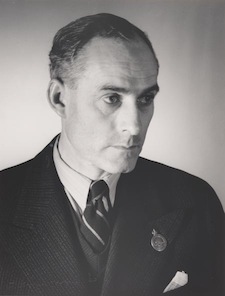
Adrian George Feint was an Australian artist. He worked in various media, and is noted for his bookplate designs.
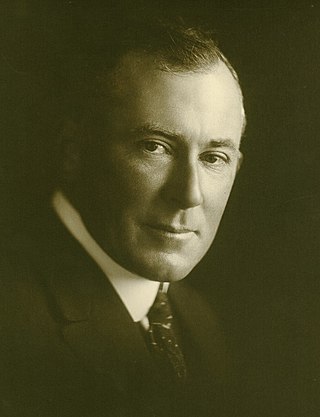
Sir John William Ashton, OBE, ROI was a prolific Australian Impressionist artist and director of the National Art Gallery of New South Wales from 1937 to 1943.
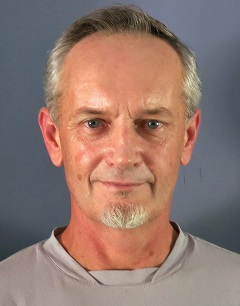
Andrew Baines is an Australian artist based in Adelaide, South Australia, known for his "quasi-surrealist" paintings of politicians in exposed positions and bowler-hatted office workers on beaches, and "living statues". He does a lot of work for charities, particularly those focussed on the plight of homeless people.
Frederick Christian Britton was an artist and arts educator in South Australia and New South Wales.
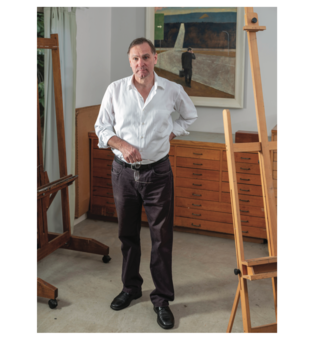
Peter Serwan is an Australian artist and educator based in Adelaide, South Australia. Serwan works mostly in the medium of oil paint however he is also a fine printmaker. Serwan is known for his paintings' focus on suburban life and the human experience. His artwork features both impressionist works as well as key figures from his own like including family and friends. His works have been known to showcase the nuanced exploration between human existence and urbanization. Serwan has exhibited frequently in Australia and is represented in private and institutional collections.
John Neylon is a South Australian arts writer and arts educator as well as being an art critic, curator, painter, and printmaker. He is an art critic for The Adelaide Review, an author for Wakefield Press, and a lecturer in art history at Adelaide Central School of Art.
William Frater (1890–1974) was a Scottish-born Australian stained-glass designer and modernist painter who challenged conservative tastes in Australian art.

Rosemary Wynnis Madigan was an Australian sculptor, stonecarver and woodcarver who focused on the human figure. Born in Glenelg to the geologist Cecil Madigan, she decided on a career as a sculptor at the age of 12 and studied in schools in Adelaide and Sydney. Madigan won a three-year scholarship to study abroad from 1950 to 1953. She began teaching pottery, painting and sculpture at various schools between the 1950s and the 1960s. Madigan was in a working partnership with the constructivist sculptor Robert Klippel until the latter's death in 2001 and won the Wynne Prize for a carved sandstone torso in 1986.
Jacqueline Hick was an Australian painter whose work is held in the permanent collections of multiple museums in Australia. She is known for her work depicting human figures and the Australian landscape. She is the subject of the 2013 book Jacqueline Hick: Born Wise.
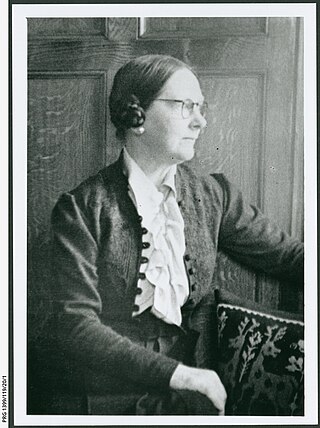
Marjorie Gwynne was an Australian artist who lived in Adelaide. She worked both in oils and watercolours and was known for her strong use of tertiary colours especially in landscape and still life. Her early style was impressionist, but later developed a more modernist style, influenced by Dorrit Black.
Kathleen Margaret Sauerbier was a South Australian pre and post-war Modernist artist who painted landscapes, portraits and still-life, mainly in oils. Her artworks are held in the National Gallery of Australia in Canberra, the Art Gallery of South Australia and at the University of Western Australia as well as numerous private collections.
References
- ↑ "Progressive Wondergraph". The Register (Adelaide) . South Australia. 22 May 1926. p. 13. Retrieved 17 March 2020– via Trove.
- ↑ "Art master at work". The News (Adelaide) . South Australia. 28 December 1950. p. 17. Retrieved 18 March 2020– via Trove.
- ↑ "David Clyde Dridan b. 1932". Carrick Hill Trust. Retrieved 18 March 2020.
- 1 2 Max Germaine, ed. (1979). Artists and Galleries of Australia and New Zealand. Lansdowne Editions. ISBN 0868320196.
- ↑ "Dridan, David 1962-". WorldCat Identities. Retrieved 19 March 2020.
- ↑ Patrick McDonald (15 December 2023). "David Dridan travels from the backwaters of the Coorong". The Advertiser (Adelaide) . Retrieved 15 December 2023.